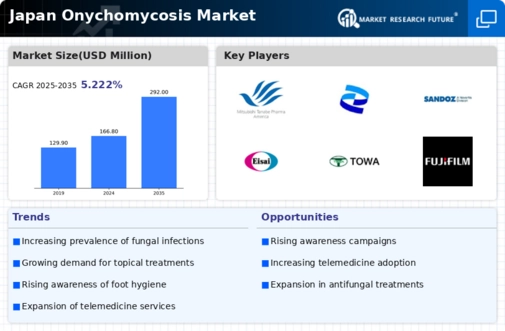Growing Demand for Topical Treatments
The growing demand for topical treatments is a notable driver of the onychomycosis market in Japan. Patients often prefer non-invasive treatment options that can be applied directly to the affected area, minimizing systemic side effects. Recent market analysis indicates that topical antifungal agents account for a substantial share of the overall market, with a projected growth rate of around 8-10% annually. This trend is likely fueled by the increasing availability of over-the-counter topical solutions, which empower patients to manage their condition independently. As awareness of these options expands, the onychomycosis market is expected to experience a corresponding increase in sales of topical treatments, reflecting a shift in patient preferences towards more accessible and user-friendly solutions.
Increasing Incidence of Onychomycosis
The rising incidence of onychomycosis in Japan is a critical driver for the onychomycosis market. Recent studies indicate that approximately 10-15% of the population may be affected by this fungal infection, particularly among older adults. This demographic shift, coupled with an increase in risk factors such as diabetes and immunocompromised conditions, suggests a growing patient base. As the prevalence of onychomycosis continues to rise, healthcare providers are likely to seek effective treatment options, thereby stimulating demand within the onychomycosis market. Furthermore, the economic burden associated with untreated onychomycosis, including potential complications and healthcare costs, underscores the necessity for effective management strategies, which may further drive market growth.
Rising Interest in Preventive Healthcare
Rising interest in preventive healthcare is emerging as a key driver for the onychomycosis market in Japan. As public awareness of health and wellness increases, individuals are more inclined to seek preventive measures against fungal infections. This trend is reflected in the growing sales of antifungal products, including foot powders and nail care solutions, which are marketed for their preventive benefits. Furthermore, educational campaigns aimed at promoting foot hygiene and awareness of onychomycosis are likely to enhance consumer engagement. As preventive healthcare becomes a priority, the onychomycosis market may witness a surge in demand for products that not only treat existing infections but also prevent their occurrence, indicating a shift towards a more proactive approach to health management.
Aging Population and Healthcare Accessibility
The aging population in Japan is a significant driver of the onychomycosis market. As the demographic landscape shifts, with a growing proportion of individuals aged 65 and older, the incidence of onychomycosis is likely to increase. Older adults are more susceptible to fungal infections due to factors such as reduced immunity and comorbidities. Additionally, improved healthcare accessibility in Japan, including enhanced insurance coverage for dermatological conditions, facilitates timely diagnosis and treatment. This combination of an aging population and better access to healthcare services is expected to contribute to the expansion of the onychomycosis market. Consequently, pharmaceutical companies may focus on developing targeted therapies to cater to this demographic, further driving market growth.
Technological Advancements in Diagnostic Tools
Technological advancements in diagnostic tools are significantly influencing the onychomycosis market in Japan. The introduction of rapid and accurate diagnostic methods, such as polymerase chain reaction (PCR) testing and advanced imaging techniques, enhances the ability to identify fungal infections promptly. This improvement in diagnostic accuracy not only facilitates timely treatment but also reduces the risk of misdiagnosis, which has historically been a challenge in managing onychomycosis. As healthcare providers increasingly adopt these innovative diagnostic solutions, the demand for effective antifungal treatments is likely to rise, thereby propelling the growth of the onychomycosis market. The integration of technology in diagnostics may also lead to better patient outcomes, further encouraging investment in this sector.




















Leave a Comment